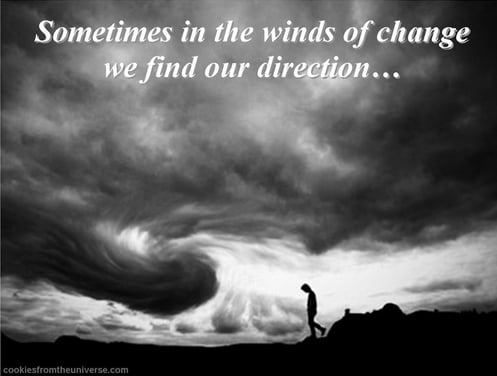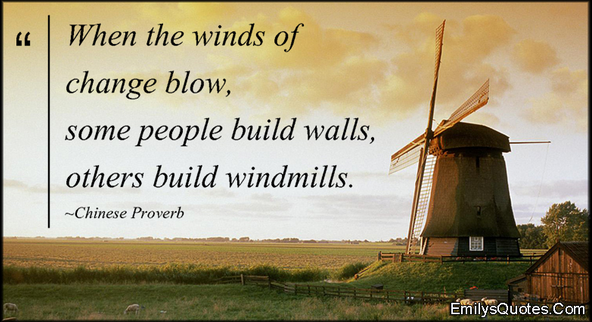 Anyone who has felt the ‘full force of the wind’ will know the feeling of how hard it is to keep on your feet, to stay determined to stay upright and true, to hold the course, whatever happens.
Anyone who has felt the ‘full force of the wind’ will know the feeling of how hard it is to keep on your feet, to stay determined to stay upright and true, to hold the course, whatever happens.Ignoring the power of choice within change is dangerous
Constructing a climate for any transformation is hard. Our cultures are deep-rooted; we resist those winds blowing into us “full-on,” well beyond being reasonable or smart enough to avoid them before they confront us. The Chinese proverb below gives us a clear choice: “to build walls or build windmills”

When an organization decides to change its culture, set about constructing a different climate or environment so innovation can thrive. But there are so many steps to work through, so many obstacles to overcome, bridges to burn, habits to undo as well as construct the path of understanding, of recognition and providing the building blocks to this.
So often the top organizations keep delivering their message from the top, they so often fail to listen to the message from the bottom. Change is often resisted simply because the organization never takes the time to really listen to the views of the very people they expect to simply change..
Context is the vital ingredient often never told for innovation.
Often we hear “location, location, location” as the mantra for the real-state property. What should the mantra be for innovation? For me, it is “people, people, people” followed by “context, context and context”. We have often heard (and it is totally right) that innovation only happens through people. Everything else – systems, processes, structures, incentives and investments, sets the context that defines how people approach their jobs.
Context not only sets the stage, it gives us the reason to go and find the tools to get the job done but it is ‘our’ people who need to be motivated to go find them and apply them.
The power of context also refers to the conditions and circumstances of time and place for combining new ways to make a shift, a new understanding, perhaps to make the organization more sensitive to the need for innovation, to help fully support the people to innovate.
Context is powerful but only in the hands of knowledgeable people.
So to make the change we need context – the understanding of why we need to change and what we need to do with it. Then we can begin to think of the climate and eventual culture we want to have so as to achieve the change.
These actions shape behaviours that alter perceptions, establish themselves within the larger social group that change is directed towards, it alters the ‘norm’, opens up new possibilities and pushes the established boundaries.
Innovation is very fluid; we build systems that often impede it.
I kept a reference but I can’t recall who wrote it:
“An idea tends to be very fluid, and without context may be hard to evaluate or even consider. Certainly, any culture that discourages ideas will produce few, that rewards people for complying will not promote challenges and make the necessary breakthroughs business require today in new and different thinking. Having systems that minimize risk will also minimize innovation and risk-taking. Structures built to control only impede the very interactions that innovation thrives off of and restricting the movement of ideas will completely undercut the capacity for innovation”.
So companies need to put a great amount of attention on the context that will allow people to work clearly and effectively and provide the vital enablers that contribute to making this happen.
This power of context is something we are extremely alert or sensitive to, and when these change and we don’t understand why, we often just stop innovating, or being productive and often become disinclined to be creative. So making change for reasons that are seen as not clear to those involved stops people from doing their job of making innovation happen.
Context may be the arbitrator of success but people are first and foremost, hence why my two mantras are both critical “people followed by context” that are inexplicably linked for successful innovation but these should always be placed in the right order and recognition; people come first, context follows, innovation flows from the combination and you have the best chance to bring about positive change.
Actually making change for innovation is a lot harder.
Let me explain: Innovation, however, doesn’t work in many of our normal processes and procedures. Yes, we constantly attempt to squeeze all our innovation activity into a well-designed process but so many of those more radical innovations just cannot fit and we are then forced to ‘kill them off’ as the system rejects them.
We block any chance of making a radical change if we remain slaves to the pursuit of structured innovation alone. We should find ways to become flexible, more agile, and more ready to work with ambiguity and find the ways and means to challenge the consistent process for innovation.
Transactional processes have their context embedded in them, they are often just repeatable. Innovation, on the other hand, needs to attach context to every idea or concept, it needs to be moulded, shaped and aligned to the greater purpose, it is constantly unique and challenges the mindsets looking for simply efficiency and effectiveness.
A lot of innovation is actually not repeatable as it relies on creativity, discovery and intuition to overcome specific obstacles, all we can try to do is make them as efficient and effective as we can.
Encouraging change has one very powerful empowering step
If you encourage a certain readiness, willingness and ability to want to transform – then you must devolve power down to the individual to experiment, create, develop, to test, and then they will want to innovate.
They need to engage and identify, innovation derives from a concept in someone’s mind, who puts this into a context that others can relate to and out of this beginning comes the wish to develop and deliver this idea or concept into a final innovative product or service.
It is not the mechanical systems or processes that innovation often requires, it is the intellectual effort from the people wanting to engage in what it changes for them and those that benefit from something better and different.
Encouraging the forces, let them run free
Let those winds blow but do be ready to seek out all those within your team to harness the full forces of this change, to fill the sails that give you that momentum to move forward and pick up speed. If you lack the coordination of effort, when it is needed, and show poor commitment and enthusiasm, you create a real drag on performance.
You can often anchor and constrain the initiatives, you subject ‘forces of real negative tension’ that pulls in the opposite direction, holding everything and everybody back and eventually those full forces break free and run wild, ending up being totally out of control and all the creative energies are dissipated and going in all directions.
Remember we all need the provision of tools, encouragement, the time and space to adjust to change, to experiment and adjust, to become more comfortable, to validate a better course of action or way. We should always give liberally out the tools to do the job, but explain their purpose. We need to create the time to experiment and get used to what this means, keep adjusting and learning from the experience.
Focus constantly on the training and support always needed, you will surely lift any performance.
Finally innovation needs ‘team performance’ it struggles in isolation, it needs framing, context and dialogues to spark and evolve, and yes, always give praise and encouragement on any journey of change, lots of it. It soothes the pain of uncertainty, it strengthens the resolve to make the efforts.